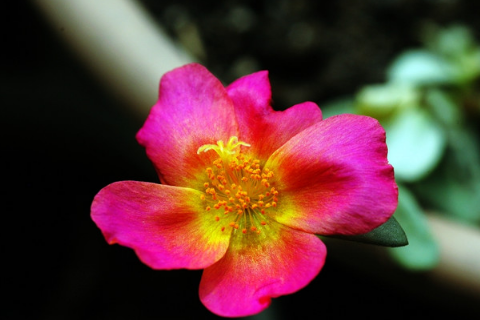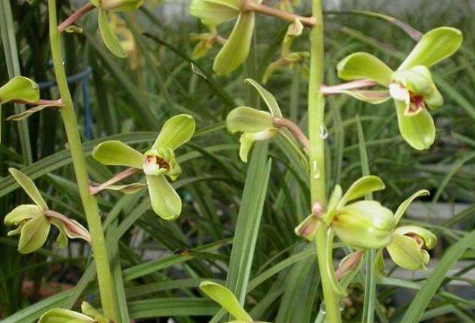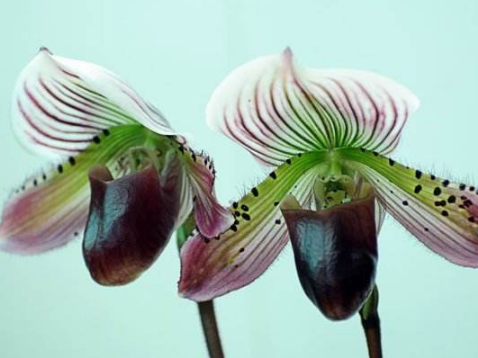How to raise the dance of falling flowers
Watering
Water the soil once a week in spring and autumn to keep the soil moist. It should be properly shaded in summer, keep the soil moist moderately in winter, and the specific watering times depend on the level of room temperature.

Fertilizer application
Fertilize once a month, choose low nitrogen fertilizer or succulent special fertilizer.
Light
Flowering period to ensure adequate light, as little as possible to move, so as not to break the stem and fall flowers.
Diseases and insect pests
Common diseases and insect pests are anthrax, red spiders, once diseased plants are found to remove diseased leaves in time, spray fungicides.
The above is about the introduction of how to raise the dance of falling flowers, let's take a look at how to cut the dance of falling flowers.
Dance of falling flowers Rhipsalidopsis rosea dance of falling flowers: dance of falling flowers how to raise / dance of falling flowers how to breed the dance of falling flowers the business card the dance of falling flowers the introduction and precautions of the dance of falling flowers the dance of falling flowers generally blossoms from April to June, the plant is much branched and grows in clumps, and the fleshy succulent plants are usually 3-5 edges, and there are also flat or irregular angles, edges purplish red. Its flowers are smaller and its receptacle is quadrangular. The kaleidoscope is short, the petals are monolayer, and the petals are arranged regularly and neatly. The flower is pink, which is very similar to the flower of false epiphyllum, so it is difficult to distinguish, so it is more accurate to distinguish from the stem node. The morphological characteristics of the falling flower dance are epiphytes, the plant height is 25 cm to 30 cm, the plant is much branched, growing in clusters, the stem nodes are fleshy and succulent, semi-erect, 2 cm to 4 cm long, and the shape is rich in digestibility, or with 3 to 5 edges; or only 2 edges, showing a flattened shape; or irregular angular shape, the general rule is that the lower stem nodes are multi-angled, close to shape, and the upper stem nodes are flattened, similar to crab claw orchid. There is a thorn seat on the edge of the stem node, and there are short woolly hairs and a few caducous setae on the stem node. Flowers terminal, pink to rose red, flower stems 3 cm to 4 cm, actinomorphic, with fragrance. The ecological habit of falling Flower Dance originated in southern Brazil, it is epiphytic in the trunks and branches of the subtropical jungle, preferring a warm, humid semi-shaded environment, shading and strengthening ventilation in summer, and keeping room temperature above 10 ℃ in winter to give sufficient light. Like warm and humid semi-overcast environment, there are requirements for a certain degree of air humidity, summer should be well ventilated, and avoid hot sun exposure. It is suitable for growing in soil which is rich in humus, loose and fertile, and has good drainage and air permeability. The garden use of falling flower dance falling flower dance introduced into our country is not long, its gorgeous flowers, many flowers, suitable for hanging decoration, ornamental effect is not less common crab claw orchid, it is worth popularizing. The propagation method of falling flower dance is cutting or grafting propagation. Propagation can cut the stem segment for cutting in the growing season; if the cactus with three-angled arrow and thick stem nodes are used as rootstocks for grafting, it will not only grow well, blossom more, but also have a beautiful plant shape. The cultivation technique of falling flower dance is to apply dilute liquid fertilizer every 10 to 20 days, and to apply more phosphorus and potassium fertilizer and stop nitrogen fertilizer during flower bud formation to promote the formation of more buds. There is a short dormant period after flowering, at this time to stop fertilization, control watering, and so on after the growth of new stem nodes before normal water and fertilizer management. In cultivation, water should often be sprayed to the plant to increase air humidity. This species is vulnerable to the harm of red spiders, so we should strengthen ventilation and control. Potted soil is required to be fertile, rich in humus, good drainage and air permeability. Falling flower dance and crab claw orchid, fairy finger, false epiphyllum, the difference between arrow lotus because crab claw orchid, fairy finger, false epiphyllum, falling flower dance make arrow lotus are epiphytic cactus plants, branches are stem node-shaped, so the stem nodes of these flowers, that is, the so-called "leaves" are similar in shape, and are often considered to be the same species of flowers, unified as crab orchids, but they are actually five plants of different genera. One family-genus 1. Crab claw orchid cactus family, crab claw orchid genus. two。 Cactus refers to the family Cactus, Cactus refers to the genus. 3. False epiphyllum cactus family, false epiphyllum. 4. Ling arrow lotus cactus family, Ling arrow lotus genus. 5. The cactus family of falling flower dance, genus Pseudostellaria. The second florescence / flower type 1, the flowering period of crab claw orchid is from November to December. (earliest) the petals are round and full, the petals spread evenly during flowering, and the flowering type is muddy and round. The flower tube is long and curved, the petals are multi-layered, the lower petals roll upward, and the petals are irregular and irregular. Pistil red, stamens white, all longer, protruding from the kaleidoscope. There are yellow, white, orange, pink, red, purple, snow blue and other colors, as well as multi-color varieties. From the valve type, it can be divided into acute valve, blunt valve and round valve. At present, there are more than 200 varieties of horticulture. Nodal stem margin sharp-toothed, green all over. The young leaves are purple-red and green in adulthood. (double flowers, crab claw orchids sometimes on stilts. ) 2. The fairy refers to the flowering period from December to February next year. The petals are slender, weak, multi-layered, regular and neat, and the petals fold backward when they bloom. Pistil red, stamens white, all longer, protruding from the kaleidoscope, similar to crab claw orchid. Most of the colors are pure red, peach red, bright yellow, and pure white. Nodal stem margin sharp-toothed, green all over. The young leaves are purple-red and green in adulthood. (double-layer flowers, fairies refer to flowers drooping) 3. False epiphyllum usually blossoms from April to May. (later) the petals are pointed and straight, and when they bloom, the petals extend in all directions, shaped like an open umbrella, and the petals are regular and neat. The kaleidoscope is short, and most of the flowers are pure red and pink. Nodal stem margin crenate, green, tender leaf stem purplish red, gradually green after adulthood, margin crimson. Like the fairy finger, but wider and thicker than the fairy finger stem node, the new stem node reddish relative to the crab claw orchid and fairy finger, the petals should be monolayer, receptacle five-angled. The flowers are pure red and pink. 4. The lotus flower blossoms in April, a single flower blossoms for 2 days and blossoms during the day. A single flower grows on both sides of the stem apex, with large bell-shaped flowers, perianth open and curled, filaments and styles curved, with purple, red, pink, yellow, white and so on. 5. Dance of falling Flowers 5 May-blossoms in June. (the latest) the plant is much branched and grows in clusters, and the hypertrophic succulent plants are usually 3-5-angled, flattened or irregularly angular, with purplish red edges. Its flowers are smaller and its receptacle is quadrangular. The kaleidoscope is short, the petals are monolayer, and the petals are arranged regularly and neatly. The flower is pink, which is very similar to the flower of false epiphyllum, so it is difficult to distinguish, so it is more accurate to distinguish from the stem node. The flowers and colors of crab claw orchid and arrow lotus are the most varied, with red, yellow, white and a variety of complex colors: fairies generally see pink or rose occasionally light yellow; false epiphyllum flowers are generally bright red: falling flowers are also more colorful and have a clear fragrance. Third, the difference of stem node (leaf) 1, crab claw orchid stem node (leaf) is flat, leaf edge has sharp teeth, shaped like crab claw. 2. The stem node (leaf) of the fairy finger is flat and Obovate, and the leaf edge has no sharp teeth and is shallowly wavy. 3. The stem node (leaf) is flat and oval, and the leaf margin is smooth and purplish red. 4. The stem nodes (leaves) of falling flowers are prismatic, generally trigonous, quadrangular, at most no more than five, and the edges are also purplish red. Thicker flattened stem nodes can appear under the condition of grafting. 5. Make the arrow lotus stem node (leaf) flattened lanceolate, the base is round, bright green, the edge is reddish, coarsely serrated, the concave part of the sawtooth has fine thorns, and the midrib is obviously raised. Fourth, the basic characteristics are different. Crab claw orchid is also called icing on the cake, crab foot overlord whip, fairy flower and so on. Like shade, damp environment, not direct sunlight, like warm and humid, not cold-resistant. Should be fertile rotten leaf soil and peat soil, afraid of raw coal soil coal ash. two。 Fairies like sunny and warm environmental conditions. 3. False epiphyllum, also known as bright red fairy finger, likes a warm and humid environment. Keep the soil moist at room temperature during the growth period and see the light properly. 4. Make the arrow lotus like the environment with good light and ventilation, but it should be properly shaded under hot, high temperature and dry conditions, for fear of Rain Water. It requires fertile, loose and well-drained soil to have a certain ability to resist drought. 5. The dance of falling flowers likes a warm and humid environment. Falling Flower Dance Picture how to raise falling Flower Dance, 6 maintenance and planting methods
How to raise the dance of falling flowers 1. Adapt to the environment
The dance of falling flowers likes the warm, moist semi-shady environment.
2. Soil requirements
The dance of falling flowers likes the soil rich in humus and loose and fertile, so the potted soil for raising falling flowers must be fertile, rich in humus, and have good drainage and air permeability.
3. Sufficient light
The dance of falling flowers during the flowering period, ensure sufficient light, and advise flower friends to move as little as possible to avoid broken stems and fallen flowers.
4. Watering requirements
The maintenance environment of falling Flower Dance should keep the air humidity, so during the watering process, flower friends can spray some water around the falling Flower Dance to maintain the air humidity of the surrounding environment.
The dance of falling flowers is a growing season in spring and autumn, because the climate of spring and autumn itself is warm, so just water the right amount in the spring and autumn season. Generally water once a week, do not need a lot of water, keep the soil moist immediately.
When the temperature is high in summer, it should be properly shaded, and the amount of water should be kept at 8-9 days and watered immediately.
Keep the soil moderately moist in winter. If the indoor temperature is high, water once every 6-7 days, and once every 9-10 days if the indoor temperature is low.
5. Fertilization requirements
The dance of falling flowers is performed every 10 to 20 days during the growing period (spring and autumn). You only need to apply fertilizer once a month in summer and winter. It should be noted that there is a short dormancy period after anthesis, and fertilization should be stopped at this time.
In addition, the dance of falling flowers in the growing period, generally choose nitrogen fertilizer or succulent special fertilizer, fertilizer diluted thin application. The dance of falling flowers should apply more phosphorus and potassium fertilizer and stop applying nitrogen fertilizer in the period of flower bud formation in order to promote the formation of multiple buds.
6. Change the basin
The dance of falling flowers generally changes the basin every two years, and when changing the basin, the branches that are too long or too dense need to be cut short. The basin usually chooses 12-15 cm basin, and the hanging basket chooses 15-20 cm basin, with 3 plants per basin.
- Prev

Culture method of cymbidium
1. The soil flowers grow well must first raise the root system, so the most suitable soil for cymbidium is fertile loose humus soil, which is rich in nutrients and conducive to root growth. 2. Light Cymbidium is the most light-loving orchid, can adapt to strong light, but still in summer to shade treatment, other seasons will see more light
- Next

Culture methods of Paphiopedilum
1. Soil pot cultivation of Paphiopedilum can be arranged with rotten leaf soil, peat and so on. When you put on the basin, you can pad a layer of broken brick particles in the basin to maintain good air permeability and be conducive to the growth of plant roots. two。 Temperature Paphiopedilum likes a warm environment, and the suitable temperature is different for different varieties.
Related
- Fuxing push coffee new agricultural production and marketing class: lack of small-scale processing plants
- Jujube rice field leisure farm deep ploughing Yilan for five years to create a space for organic food and play
- Nongyu Farm-A trial of organic papaya for brave women with advanced technology
- Four points for attention in the prevention and control of diseases and insect pests of edible fungi
- How to add nutrient solution to Edible Fungi
- Is there any good way to control edible fungus mites?
- Open Inoculation Technology of Edible Fungi
- Is there any clever way to use fertilizer for edible fungus in winter?
- What agents are used to kill the pathogens of edible fungi in the mushroom shed?
- Rapid drying of Edible Fungi

